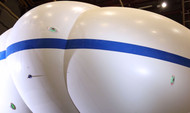SPIDER: The Answer for Lockheed Martin Airship Repair
By on Aug 2nd 2016
A Robotic SPIDER may hold the answer to furthering hybrid airship efficiency
While the airship industry certainly isn’t “huge” compared to other methods of [aviation] transportation technology, it is seeing a resurgence–especially with Lockheed Martin’s P-791 Hybrid Airship. Hybrid Airships, Lockheed Martin claim, offer the benefits of “large cargo capacities with significant reductions in fuel consumption compared to other air vehicles while remaining faster than land and sea transportation systems.”
Sounds fantastic, right? There certainly is nothing better than high-efficiency air travel –unless, of course, the means to repair the craft hinder the overall efficiency.
How do you repair an airship?
Holes happen. They come with the territory of an aircraft consisting of an inflated envelope. Even the tiniest pinholes affect aircraft efficiency: a non-airtight envelope can significantly affect the airship’s efficiency and, overtime, its ability to fly.
How do you repair these holes? Up until now, this has always been a manual task. Traditional airship maintenance involved a crew of workers partially inflating the envelope while one team located holes using a bright light while another team inside patched them. This method has always been time consuming and expensive–neither characteristic wanted for an innovative project.
In comes Lockheed Martin’s SPIDER.
SPIDER
The solution to the human problem is, naturally, a robot. Lockeed Martin’s Skunk Works researchers developed SPIDER (which stands for Self-Propelled Instruments for Damage Evaluation and Repair) to inspect airship skins for holes and repair them.
Hybrid airship engineer told IEEE Spectrum the concept “originated when the P-791 Hybrid Airship demonstrator flew 10 years ago. The idea of eliminating the pinhole check, a serial step in the production schedule, is attractive when you are producing a significant number of large airships each year. SPIDER allows this check to be performed in parallel with the airships final assembly.”
The SPIDER works in a manner somewhat similar to magnet-style cleaners for fish tanks. The robot is actually two halves: one half goes on the exterior of the envelope, and the other on the interior. Magnetically-coupled, the robot moves across the entire surface of the envelope; the outer half shines light on the airship’s surface while the inner half detects potential pinholes using light sensors in the (otherwise) dark envelope. When SPIDER detects a hole, it is able to repair it using a patching mechanism, and then sends before and after photos of the area for repair verification.
Streamlining airship repair helps to establish better overall efficiency for the utilization of hybrid airships–an aircraft that Lockheed Martin believes will define sustainability for the future.
You can read the entirety of Ben Szpak's interview with IEEE Spectrum here.







